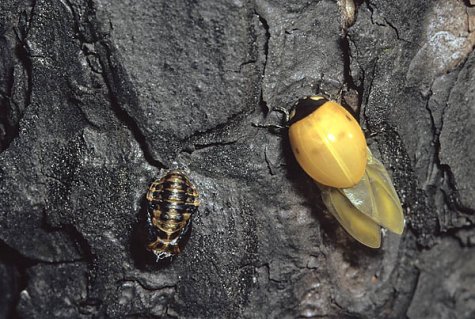About ladybirds
Photos: Urmas Tartes
Translation: Liis
Ladybird larva
| Seven-dot ladybird | Seitsetäpp-lepatriinu |
You see the larvae of ladybirds quite often in summer. They have faint orange spots on its body, providing a sort of negative image of the future ladybird’s pattern. Our best known ladybird, the seven-dot ladybird (the seven dots characterise the species) lays its eggs closer to the sources of food as the weather gets warmer. The food of the larvae as well as the imagos is basically Arthropoda („jointed feet“) creatures: the imagos and larvae of aphids, mealy bugs, mites, leaf beetles ...
The ladybird female can lay about three hundred oval, yellowish eggs (about a millimetre long) in the course of three months. Her fertility depends clearly on the availability of food. During its development cycle a ladybird will have eaten about a thousand aphids (greenflies) – a hundred adult aphids or three hundred larvae per day.
Ladybird moulting on a charred tree trunk after forest fire.
The imago annihilates about a hundred aphids a day; when one colony is eliminated they quickly find the next – it is the pretty favourite of our gardeners.
If you do not use pesticides in your garden you can bring in ladybirds from elsewhere – they will not fly away as long as there is enough prey. They lay eggs too and so there will be a next generation of aphid fighters in your garden. Leave a heap of leaves in a corner of the garden in autumn, there the ladybirds will survive the winter snugly.
In addition to the seven-dot ladybird we can meet other quite common ones: the five-dot and two-dot ladybirds. The bright red colour sends a signal to insect eaters – “we aren’t edible“. Who attacks gets a dose of corrosive, nastily smelling and tasting orange haemolymphatic fluid, and then the ladybirds will certainly be left alone.










